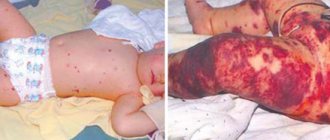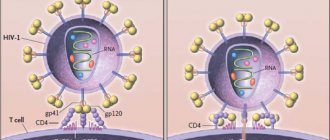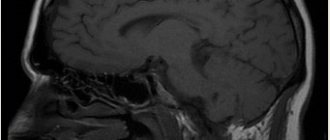Infectious disease specialist
Sinitsyn
Olga Valentinovna
33 years of experience
Highest qualification category of infectious disease doctor
Make an appointment
HIV (human immunodeficiency virus) is a virus that attacks the body's immune system. More precisely, it targets certain immune cells and kills them. The longer and more active this process lasts, the weaker the immune system becomes - over time, it is simply unable to cope even with infections that are relatively safe for an ordinary person.
HIV and AIDS - differences, duration of development, forecasts
AIDS is the final stage of HIV, which is characterized by severely reduced immunity. It is important not to confuse these two concepts. From the moment of HIV infection, the disease can develop to the AIDS stage without treatment within 9-11 years (on average). Once diagnosed with AIDS without treatment, life expectancy is short - on average up to 19 months.
If you start treatment on time, you can live a very long life at the HIV stage - the life expectancy of such patients thanks to modern treatment is 20-50 years. And although at the AIDS stage the situation is much more complicated, many patients, with proper treatment and a strong body, can live more than 10 years.
It is obvious that taking therapy is the most important factor for treating HIV and living a full, long life. Moreover, it is treatment that can significantly reduce the viral load and make the infected person harmless to the partner, as well as family members.
Routes of HIV transmission
Main routes of HIV infection:
- unprotected sex with an infected person (the most common route of HIV transmission). You can become infected either after a single contact or after several;
- using a needle to inject drugs after an infected person. Or other variants of situations in which the blood of a healthy person comes into contact with the blood of an infected person;
- transmission from mother to fetus during childbirth or from mother to child during breastfeeding. An important note: if a woman is treated and is under the supervision of doctors, she has every chance of giving birth to a healthy baby;
- transfusion of infected blood. In modern clinics and hospitals this is no longer possible, since all materials undergo very serious testing.
There are also so-called risk groups - these are people who are more susceptible to HIV infection than others:
- people who are promiscuous;
- homosexuals;
- drug addicts who inject drugs;
- people with a partner infected with the virus.
Such people should constantly get tested. In some cases, they are recommended to take preventive medications (only on the recommendation of a doctor).
When talking about how you can become infected with HIV, you should clarify in what cases this is impossible:
- during everyday contacts;
- when using infected utensils;
- with an insect bite;
- when kissing.
Contact with an HIV-infected person at the everyday level (in the family, at work, in other forms of communication) is absolutely safe and does not pose any threat to others.
Main stages of the disease
The stages of HIV are divided into the following:
- incubation This is the stage at which infection and subsequent multiplication of the virus in the blood occurs. It lasts up to six weeks, sometimes less. Even if infected, at this stage a person will not see obvious signs, and a blood test will not show that there are antibodies in the blood;
- primary. The first signs of infection may already appear here. The second stage lasts for 3 weeks - at this time antibodies appear, the virus is determined in the laboratory;
- subclinical. The first sign of the disease appears - enlarged lymph nodes. The patient feels completely healthy and does not complain about his health;
- the appearance of secondary diseases. The immune system begins to malfunction, causing a variety of diseases to appear: from frequent colds and candidiasis to pneumonia, tuberculosis;
- terminal. The stage involves exhaustion (rather rapid and progressive), as well as the subsequent death of the patient.
The stages do not have one correct time frame - they may differ from person to person. For example, HIV-infected people often feel well for years or do not pay attention to small signs. The disease is detected only at the stage of severe deterioration in health or through random tests.
Magnetic resonance imaging for HIV
It is believed that changes in the brain in HIV-infected and AIDS patients can be caused by various factors, such as various types of opportunistic infections, tumor process, cerebrovascular diseases, demyelinating process, as well as the direct effect of the immunodeficiency virus, and lesions of the central nervous system can develop both simultaneously or in parallel with HIV infection, and metachronously, i.e. some time after infection [4,5]. It is well known that opportunistic infections are the most common in AIDS patients, i.e. in approximately 30% of patients. These include toxoplasmosis, herpetic, cytomegalovirus, cryptococcal, tuberculosis, papovavirus and other infections [1].
It should also be noted that the clinical manifestations of brain damage in AIDS depend to a greater extent on the localization of changes in the central nervous system than on the etiology. Thus, in particular, both single- and multifocal lesions can occur, which can be accompanied by mass effect [3].
It is known that the main most informative methods of neuroimaging at present are X-ray computed tomography (CT) and magnetic resonance imaging (MRI). When CT diagnoses AIDS, as a rule, either no changes in the brain matter are detected, or mild atrophy is detected with areas of low density in the white matter.
MRI diagnosis of AIDS, as well as in inflammatory diseases in persons with unchanged immunity, is based primarily on the assessment of direct signs of the pathological process and the nature of the enhancement, which, by the way, may be less clearly expressed than usual. Most often, brain damage in immunodeficiency (without signs of another neuroinfection) is manifested by diffuse atrophy, which is observed in 31% of subjects with asymptomatic HIV infection and in 70% of patients with clinical manifestations of AIDS [4].
Symptoms of HIV
Once you know how HIV is transmitted, you need to understand the symptoms. The problem is that these symptoms appear at an early stage, then disappear and no longer bother the person for a long time - literally for years. They are also very similar to the manifestations of other diseases, which can be misleading.
So, at the first stage, when the virus manifests itself, a person may feel:
- sore throat, fever;
- soreness of the skin, joints, bones4
- chills, fever.
At the same time, the cervical lymph nodes enlarge and various rashes may appear. All this is often mistaken for signs of ARVI or other similar diseases.
New HIV symptoms return after several years of a calm and healthy life. These include:
- severe fatigue, fatigue;
- enlargement of lymph nodes - not only in the cervical, but in several groups;
- weight loss. Usually it looks causeless, the person does not understand what is going on;
- fever, chills, sweating (mostly at night);
- problems with the gastrointestinal tract - usually manifested by loose stools for no apparent reason.
At this stage, as a rule, the disease is detected - because the patient goes to the doctor, and the specialist prescribes an additional examination.
Are you experiencing symptoms of HIV?
Only a doctor can accurately diagnose the disease. Don't delay your consultation - call
HIV
Herpes
14222 04 September
IMPORTANT!
The information in this section cannot be used for self-diagnosis and self-treatment.
In case of pain or other exacerbation of the disease, diagnostic tests should be prescribed only by the attending physician. To make a diagnosis and properly prescribe treatment, you should contact your doctor. HIV: causes, symptoms, diagnosis and treatment methods.
Definition
HIV (human immunodeficiency virus) is an infectious chronic disease, transmitted by contact, slowly progressing and characterized by damage to the immune system with the development of acquired immunodeficiency syndrome (AIDS). AIDS is the final stage of HIV infection, when due to a weakened immune system a person becomes defenseless against any infections and some types of cancer. The danger is posed by so-called opportunistic infections - diseases caused by opportunistic or non-pathogenic flora: viruses, bacteria, fungi, which in healthy people do not lead to serious consequences or occur easily and are cured on their own. With AIDS, they overlap each other, have a protracted course, are difficult to treat and can cause death.
Causes of HIV
The source of infection is a person infected with HIV at any stage of the disease. The virus is transmitted through blood, semen, vaginal secretions, and breast milk.
Sexual intercourse (unprotected sex with an infected partner) is the dominant factor in the spread of HIV infection.
Transmission of HIV from mother to child can occur at any stage of pregnancy (through the placenta), during childbirth (when passing through the birth canal) and breastfeeding (in the presence of ulcers, cracks on the mother’s nipples and in the child’s mouth).
A high risk of infection exists when intravenously administering narcotic substances with non-sterile syringes, when transfusing HIV-infected blood and its preparations, and using medical and non-medical instruments contaminated with biological fluids of a person infected with HIV. In addition, donor organs and tissues used for transplantation can pose a danger.
Once in the bloodstream, the virus penetrates helper T-lymphocytes, or CD-4 cells (a type of white blood cell), which help the body fight infections. Helper T cells have so-called CD4 receptors on their surface. HIV binds to these receptors, enters the cell, multiplies within it and ultimately destroys it. Over time, the viral load increases and the number of T helper cells decreases.
If left untreated, AIDS-related conditions and symptoms appear after several years due to a significant decrease in the number of T-helper cells.
Classification of the disease
- The incubation stage is from the moment of infection until the body reacts in the form of clinical manifestations of acute infection and/or the production of antibodies (specific proteins produced in response to the penetration of an antigen, in this case a virus).
- Stage of primary manifestations of clinical symptoms:
a) asymptomatic (no symptoms, antibodies are produced); b) acute HIV infection without secondary diseases: there is an increase in lymph nodes, fever, pharyngitis, rashes on the skin and mucous membranes, less often - enlargement of the liver, spleen, diarrhea; c) acute HIV infection with secondary diseases (sore throat, bacterial pneumonia, candidiasis, herpetic infection, etc.). These manifestations, as a rule, are mild, short-lived, and amenable to therapy. - Subclinical stage - the only clinical manifestation of the disease is enlarged lymph nodes.
- Stage of secondary diseases:
a) loss of body weight less than 10%, fungal, viral, bacterial lesions of the skin and mucous membranes, repeated pharyngitis, sinusitis, shingles; b) loss of body weight more than 10%, diarrhea or fever for more than a month, repeated persistent viral, bacterial, fungal, protozoal (caused by protozoa) lesions of internal organs, localized Kaposi's sarcoma (multiple malignant neoplasms on the skin and mucous membranes), repeated or generalized (by whole body) herpes zoster; c) cachexia (exhaustion), generalized viral, bacterial, fungal, protozoal, parasitic diseases, Pneumocystis pneumonia, tuberculosis, malignant tumors, lesions of the central nervous system. - Terminal stage - existing secondary diseases become irreversible, death occurs within several months after their development.
Symptoms of HIV/AIDS
After an incubation period of several days to several weeks, most infected people develop an acute illness with flu-like symptoms (fever, aches, general weakness, lack of appetite, headache, sore throat, swollen lymph nodes, skin rashes) . Weight loss and the formation of ulcers on the oral mucosa are possible. This phase usually lasts 7-10 days. Due to the nonspecific nature of its manifestations, the diagnosis of HIV is rarely made. Rarely, opportunistic infections are recorded at this stage of the disease. There is a cough with sputum, chest pain (with the development of pneumonia), painful blistering rashes on the skin (with herpes zoster). As a rule, health quickly returns to normal without specific HIV treatment.
After this stage, a temporary equilibrium is established between the infectious process and the antiviral immunity that restrains its development.
For a long time (8-10 years or more), the infection occurs asymptomatically or with persistent generalized lymphadenopathy - an increase in at least two groups of lymph nodes that persists for at least 3 months.
Subsequently, active reproduction of the virus and destruction of T-lymphocytes continue, a stage of secondary changes develops, which is characterized by progressive weight loss, general weakness, persistent fever, chills, and severe sweating. Clinical manifestations of opportunistic diseases determine the clinical picture of this stage: patients are bothered by cough and shortness of breath, nausea, vomiting, abdominal pain, severe diarrhea, skin rashes, severe headaches, decreased memory and attention, etc.
HIV diagnosis
Laboratory research methods:
- HIV screening.
- An examination confirming the fact of HIV infection (in case of positive or questionable screening results).
- Measuring and monitoring the amount of virus in a person’s blood - determining the viral load in persons with an established diagnosis of HIV.
- Determination of immune status in patients with HIV infection.
Screening (examination of healthy people) for HIV should be carried out on any person who believes that they may be infected, as well as before any hospitalization and surgery, all pregnant women and their sexual partners.
The examination is advisable for people at high risk of contracting HIV, for example, in the presence of diseases that have the same transmission mechanism as HIV infection (viral hepatitis B and C, sexually transmitted diseases), people who have regular unprotected sexual intercourse, injection drug addicts, children , those born to mothers with HIV infection, medical workers who have direct contact with blood at work, etc.
There are rapid HIV screening tests that can be done at home. To determine specific antibodies/antigens to HIV (HIV-1, 2, p24 antigen), blood, saliva or urine are used. The accuracy of any rapid test is lower than a test performed in a laboratory.
For a standard screening examination, antibodies to HIV 1 and 2 and HIV 1 and 2 antigen (HIV Ag/Ab Combo) are determined in the blood using an enzyme-linked immunosorbent assay (ELISA).
How is HIV diagnosed in Moscow?
There are two tests to diagnose the virus: preliminary ELISA and the most accurate immunoblot. The accuracy of ELISA is about 90%. It is recommended to carry out it 3-6 months after contact with the virus, then it gives maximum accuracy. The usual ELISA test is based on a blood test, but there are also rapid tests that help obtain information based on urine or saliva. Such texts are purchased exclusively at the pharmacy (in no case on the Internet!), since it is necessary to use officially approved products.
If the rapid test gives a positive result, you need to go to an infectious disease specialist yourself. In such a situation, as well as when ELISA in a blood test gives a positive result, the patient is prescribed an immunoblot. Its reliability is already 99.9%. Depending on the diagnosis, the diagnosis is made either on the basis of two repeated tests or a combination of both. The analysis is rechecked and only after this a diagnosis can be made. This is necessary in order to exclude false positive results that may occur during the diagnostic process.
Important: the test does not show how HIV is transmitted in a particular situation - that is, you can determine the route of infection only by analyzing your own actions.
HIV treatment
Treatment boils down to prescribing antiretroviral therapy. The patient is given a medication regimen - and it must be followed as precisely as possible, without deviating from the program. Otherwise, the virus may develop resistance to treatment and cannot be further suppressed.
Indicators of quality treatment are a decrease in the viral load, as well as an increase in CD4+ cells in the blood, which indicates the activity of the immune system.
Medicines for treatment are issued in medical institutions, patients are registered and receive medications free of charge, in accordance with the established procedure. Information about the disease is confidential - it is not sent to work, place of study or other places. The patient has the right to keep it secret (if this is not provided for in separate work contracts).
If the rules for taking therapy are followed, the virus in the blood gradually decreases; over time, the patient becomes completely safe for his sexual partner and is not able to infect anyone.
Treatment of HIV encephalopathy
Without treatment, HIV encephalopathy can be fatal. Evidence suggests that no specific treatment can cure all complications of HIV encephalopathy. People may need different medications, such as opioids, anticonvulsants, antidepressants, and antiretroviral therapy, to treat different symptoms.
Antiretroviral therapy is the main treatment for HIV. This is a combination of drugs that reduces the amount of virus in the blood. Research suggests that drugs can reverse some of the damage that occurs as a result of HIV encephalopathy, potentially improving scores on tests that measure thinking skills.
An article published in 2021 describes antiretroviral therapy as the most effective treatment for HIV encephalopathy, noting that treatment reduces the prevalence of severe cases. Treatment effects:
- reversing some brain damage from HIV
- improved results of neuropsychological and cognitive tests
- delaying the onset of symptoms indicating brain damage
However, the effectiveness of antiretroviral therapy for milder forms of HIV-associated cognitive decline is unclear. The lack of evidence is due to the fact that cognitive difficulties in such cases are minor, so they sometimes go undiagnosed.
Prevention of HIV infection
The first and most important rule is to be regularly tested for HIV, even if you have not had suspicious contacts. It is recommended to be examined once every six months - especially since there are convenient rapid tests for this.
You also need to be careful when choosing partners. You should not take the word of a person who says that he is definitely not sick - it is better to ask for the results of the study and see for yourself that you can trust him. But remember that within six months even contaminated blood may not give positive results.
HIV prevention consists of the following points:
- protected sex with non-regular sexual partners, as well as regular ones, if there is no confidence that the partner is not sick or is faithful;
- exclusion from life of drugs and promiscuity;
- maintaining general hygiene. Avoid sharing razors, toothbrushes, nail clippers, and other items that may come into contact with small wounds.
The main prevention is to be aware of the infection and always remember the danger of infection.
HIV – infection/AIDS
26.May.2021
The disease causes a disease unlike any other: pneumonia, which first appeared in five people from California. Thus began a new epidemic, which at first few people paid attention to, but which soon swept the entire globe: after a few years, tens of millions of people fell ill. Scientists soon suspected that it was a viral disease. In 1983, the human immunodeficiency virus was discovered independently by two world laboratories - specialists from the French Pasteur Institute led by Luc Montagnier and Robert Gallo's group from the National Cancer Institute in the USA. French researchers managed to see the virus in an electron microscope (later, in 2008, they received the Nobel Prize in Physiology or Medicine for their discovery), and Robert Gallo and his colleagues proved that it was this virus that causes the disease - acquired immunodeficiency syndrome (AIDS) . In 1986, scientists came to the conclusion that we were talking about genetically identical viruses, and gave them one name - human immunodeficiency virus (HIV).
Today, researchers have long known where HIV came from. HIV was transmitted to us directly from monkeys (an intermediate “host”, unlike, for example, coronavirus). As paradoxical as it may sound, it is immune activation that is the driving force behind the entire disease caused by HIV. In the human body, this virus, unlike other pathogens, multiplies only in activated lymphocytes (T-cells). When we become infected with a virus, our immune system begins to fight it, like other viruses, and activates other cells, primarily lymphocytes, thereby preparing them for infection. Thus, HIV attacks precisely those cells that are required to suppress it. When exactly the virus “jumped” from monkeys to humans can be approximately calculated by its mutations, that is, by looking at how it gradually changed. But this is not a completely accurate method: it is assumed that this happened either in the 1930s or in the 1950s. Moreover, it is possible that a similar virus has “jumped” to people more than once. Because of this, there are now two types of it - HIV-1 and HIV-2. The first type is more contagious and pathogenic. But the new strains are unlikely to be transmitted from monkey to human because it is actually quite rare.
The epidemic began in Africa: some people got sick, some even died, but before the era of globalization, HIV could not spread as quickly as it does with viruses now. Today, around the world there are already about 38 million HIV-infected people. Approximately the same number of people have died from AIDS and related diseases since the beginning of the epidemic. In some countries, this incurable disease is in third place in terms of the number of cases, after cancer and vascular diseases. In Russia, currently more than a million people are HIV-positive.
HIV is transmitted sexually, through blood and other body fluids. Unlike many other viruses, they cannot be infected either by airborne droplets, or through the skin, or through a handshake, or through dishes, so communication with an HIV-positive person is absolutely safe for others. Until recently, the highest rates of HIV infection, especially in Russia, were observed among drug users: dirty syringes are an almost 95 percent guarantee of transmission of the virus. But now the percentage of drug users among HIV-infected people has become smaller: the infection has penetrated into the heterosexual population and continues to spread within it.
Symptoms of HIV infection are similar to a cold: within a week there may be general malaise, fever, and sore throat. And then the person’s well-being returns to normal, and he can live for several years without knowing about his status - unless he is specifically tested for HIV. Acquired immunodeficiency syndrome (AIDS) is a pathological condition that develops as a result of HIV infection. The virus infects the cells of the immune system, its work is inhibited, the body of the sick person ceases to protect itself and becomes susceptible to various oncological and opportunistic diseases.
Blood tests for HIV give accurate results. One of them, an enzyme-linked immunosorbent assay (ELISA), is based on the detection of antibodies to the virus. The immune response cannot cope with HIV infection, but is developed in all infected people within 6-12 weeks. A positive result demonstrated by ELISA is cross-checked using another test called Western blotting (immunoblot). An accurate diagnosis can only be made based on the results of both systems. Another blood test for HIV is polymerase chain reaction (PCR). It can be done much earlier than ELISA, but on its basis only a preliminary diagnosis is made.
There are also rapid tests for HIV that can detect antibodies to the virus in blood, saliva or urine. Experts recommend using them three months after the suspected infection. • The incubation period lasts 2-4 weeks, but can last up to several months. The stage of primary manifestations lasts from several days to 1-2 months. The duration of the stage is from several days to 1-2 months. Characterized by lymphadenopathy and increased body temperature. Clinical symptoms are similar to those of infectious mononucleosis or a common cold (observed in 53-93% of patients). HIV antigens are detected in the blood serum of patients, and antiviral antibodies are detected 2 weeks after the onset of acute manifestations. • The stage of secondary manifestations of HIV infection (latent period) lasts from several months to 8-10 years. Immune disorders caused by HIV are characteristic. The most characteristic symptom is generalized lymphadenopathy. Damage to the central nervous system is possible, most often in the form of encephalitis with increasing dementia, as well as exhaustion without objective reasons. AT to HIV and a decrease in the number of CD4+ cells are determined in the blood. • Late HIV infection is manifested by the development of opportunistic infections that develop as a result of a progressive decrease in the number of CO4+ cells. The most typical are: Pneumocystis pneumonia, toxoplasmosis, candidiasis (pathognomonic lesions of the esophagus and respiratory tract), generalized CMV and herpetic infection. The late terminal stage ends with the development of AIDS. The development of AIDS is indicated by the development of opportunistic infections in the patient; progressive wasting syndrome in adults or developmental delay in adolescents, neoplasia (Kaposi's sarcoma, non-Hodgken lymphoma, etc.), mental disorders (for example, dementia). However, the development of the above conditions, which are markers of AIDS, significantly depends on the severity of immunodeficiency, which only emphasizes the entire conventionality of the concept of AIDS.
Medicines for HIV are being improved all the time: gradually they should become less toxic. Ideally, a person should not take them every day - it is better if it is a drug that acts for a long time. Another development option is to combine several medications into one. With the support of modern drugs, an HIV-infected person can live a normal life almost as long as healthy people not infected with the virus. In addition, even if an infected person takes medications that suppress the virus for the rest of his life, and he manages to live a normal life, sometimes, for completely unknown reasons, immunoactivation occurs in his body, which contributes to the development of many other diseases, the causes of which are not yet fully understood, for example , cardiovascular diseases. It has long been known that general immunoactivation leads to infarction. This process leads to the fact that HIV-infected people, even those undergoing antiretroviral therapy, may suddenly develop diseases characteristic of older people: cardiovascular diseases, brittle bones, some psychological disorders, diabetes.
American Timothy Ray Brown is considered the first person to be cured of AIDS. In 2007, Brown underwent a hematopoietic stem cell transplant to treat leukemia. And although Brown stopped taking antiviral medications, even three years after the operation, doctors did not find the immunodeficiency virus in his blood. This happened because the doctors chose the donor for the transplant because of a rare mutation characterized by the absence of the second protein of T-lymphocytes, to which HIV attaches to infect the cell. However, transplantation of hematopoietic bone marrow cells is a dangerous procedure; complications after it can be worse than HIV itself, which precludes its mass implementation. Current treatment for HIV and AIDS typically consists of highly active antiretroviral therapy (HAART) and symptomatic treatment for opportunistic infections. The sooner a person starts antiretroviral therapy, the more effective it will be. One of the main problems in suppressing HIV is the ability of the immunodeficiency virus to modify its RNA and mutate, adapting to life in different conditions. Modern HAART is based on the simultaneous use of several medications that prevent various stages of HIV development and suppress mutant forms of the virus. With the support of modern drugs, an HIV-infected person can live a normal life almost as long as healthy people not infected with the virus.
BU "Surgut City Clinical Clinic No. 3"
Popular questions and answers about HIV
How does HIV manifest in men and women?
The symptoms of HIV in women are exactly the same as the symptoms of HIV in men. Manifestations may differ only at the level of genitourinary diseases, when the body is already very weakened - for example, thrush appears more often in women. Otherwise, there are no specific signs by gender.
Is there a cure for HIV?
Technically, we can say that there is no cure for HIV - patients are constantly required to undergo special therapy. But the results that it allows to achieve make the patient a healthy person who can live calmly for decades without any problems - you just need to constantly take medications and monitor your health.
HIV has not been a fatal disease for a long time!
Is HIV a disease of drug addicts and people with disordered lifestyles?
In fact, this is a myth that HIV activists are constantly dispelling. Unfortunately, a person who leads a healthy lifestyle and is responsible for their relationships can also get this disease. It is enough that a sexual partner can cheat – and in this way “bring” illness to the couple. HIV is not always a sign of an irresponsible attitude towards one’s life.
Who are HIV dissidents?
These are people who, contrary to scientific data and common sense, deny the existence of the virus. They refuse treatment, which inevitably leads to early death. Such people are also dangerous because, due to lack of treatment, they spread the virus among their sexual partners without warning them of the possible danger (because they do not believe that it exists).
The success of HIV treatment and long life lies in seeking help and starting therapy as early as possible. In this case, a person will have a long life without fears and difficulties.










